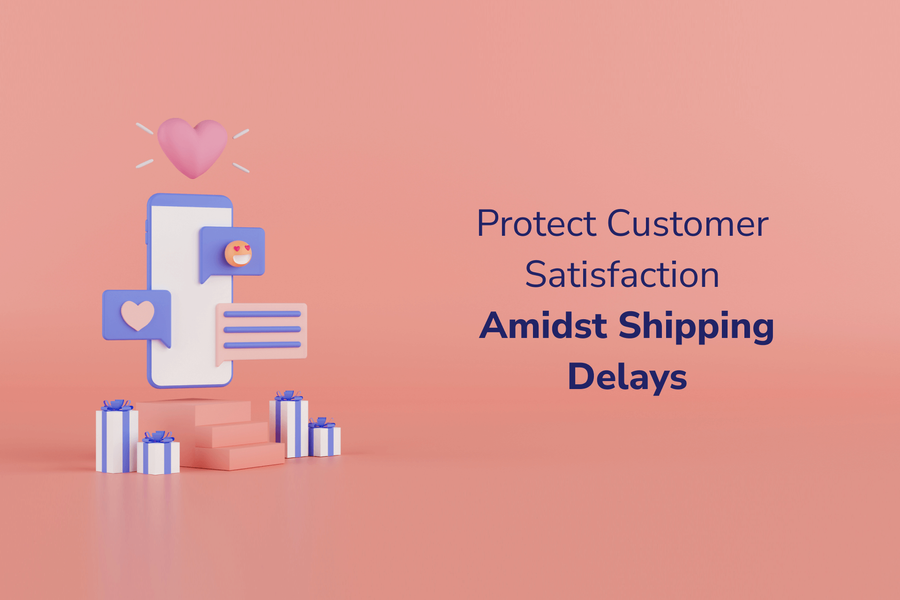The global pandemic has created ruptures and complications in the global supply chain, which have in turn stalled the movement of goods and services across a variety of industries.
These issues run much deeper than what retailers, eCommerce brands, and shipping companies can independently control; they stem from a variety of factors including natural disasters, continued Covid outbreaks, container shortages, and labor scarcity.
Despite the supply chain bottlenecks and inflated prices, the 2021 Holiday Season shattered records. The holiday shopping season started earlier than ever before and shoppers spent over $36 billion online during Cyber Week alone, which accounts for 17 percent of the shopping season.
The ripple effects of a fractured supply chain paired with a frantic holiday shopping mentality during key months make it ever-more important for companies to communicate potential shipping, delivery, and stock updates to an audience of avid shoppers.
Beyond the holiday season, communicating about shipping delays and other fulfillment hiccups can protect your brand reputation, prevent revenue loss, and build brand loyalty even when unexpected circumstances arise. Below are our proven tips to weather supply chain issues without losing customers.
1. Be transparent about shipping and inventory delays on your website.
Given the scope of this year’s supply chain issues, your business likely won’t be able to prevent the shipping and inventory delays you’re going to face. Clogged ports, overseas manufacturing disruptions, and transport delays are all tricky pieces of the puzzle. This year, one in four consumers expressed being "very concerned" about stockouts and shipping delays in the face of this holiday season.
To ease your customers’ fears, prepare to be as vocal and transparent as possible across every messaging touchpoint, and throughout the buying process. Be clear about your anticipated inventory shortages and shipping delays before customers make a purchase, starting with your website. Communicate forecasted delays and their estimated lengths/durations in multiple places on your site, such as your site header, product detail pages, within your checkout flow, and via web push notifications.
Warning your customers about these delays as explicitly and as early as possible is critical, as you want to set realistic expectations for when an order will arrive. It’s better to be honest than to overpromise and underdeliver. For example, in their 2021 Holiday Forecast, Salesforce urges brands to get ahead of increased margin and price pressure by "communicating clearly and often" with shoppers. Take a similar approach with your order updates.
Although it's not an ideal situation to be in, your customers will ultimately respect your brand more for communicating reliable information during an inconvenient time. This in turn will build on long-term brand trust and loyalty.
2. Keep customers informed about shipping deadlines
On your mission to maintain customer satisfaction throughout this year’s digital shopping experience, you should communicate shipping deadlines across various channels. Using channels such as web push notifications, SMS, and mobile push notifications to inform your customers of relevant shipping deadlines, such as when to place an order for it to arrive on or before Christmas, can be powerful. This can ease your customers’ stress and help them plan ahead by informing them of the relevant cutoffs and time constraints they’re facing. Consider promoting “Shop Early” messaging across channels.
Reaching out via multiple channels and at different times is a wise choice, given that this makes it harder for your customers to miss an important deadline.
3. Generate urgency and drive return purchases with low inventory notifications.
Use timely channels like mobile push and SMS to send users low inventory alerts. These real-time channels are ideal for these types of time-sensitive updates in that consumers benefit from seeing and acting on them right away.
With significant warehousing and manufacturing issues, low inventories are not only possible but expected. With demand surging for goods of all kinds — especially apparel, sporting goods, baby products, and electronics — certain categories are inevitably running low on stock and businesses need a strategy for communicating these shortages. Since the pre-pandemic era, out-of-stock messages have risen 172 percent. That being said, it’s best that you have a plan in place to communicate low inventory (and out-of-stock) messages.
Given the unpredictability of many supply chains, your customers will be grateful to know that the item or items they expressed interest in are running out. It’s wise to trigger and automate these messages as products dwindle. Trigger your low inventory updates when your inventory reaches a critically low threshold.
As a classic example of the scarcity principle, low inventory messages also work to promote a sense of buying urgency, which pushes users closer to purchase on a subconscious level.
4. Let customers know when an item they love is back in stock.
Sometimes selling out of an item is inevitable. In 2021, digital commerce saw four to five times more out-of-stock product messages than in previous years.
If a customer expresses interest in an item that’s currently out-of-stock (through their browsing behavior, for example) you should plan to re-target them with a “back-in-stock update” as soon as you have the inventory again. You can prompt customers to sign up for these alerts and give them an opportunity to share their email or phone number to get alerted when it's available.
Make sure that your back-in-stock alert is written with clear copy, a call-to-action, and the appropriate link to revisit the desired product page. Focus on creating a seamless path back to purchase. You can even enhance these notifications with a bit of scarcity messaging, such as: [item name] is back in stock, don’t wait for it to run out again!
Back-in-stock messaging turns a negative into a positive both for you and your customers, curbing the disappointment around out-of-stock messaging and recovering revenue for your company. You should automate and trigger your back-in-stock messages so users can seamlessly re-engage and make their desired purchase.
5. Provide real-time order delivery updates.
Keeping your customers in the loop throughout the entire buyer’s journey from pre-purchase, to post-purchase, and to delivery contributes to brand trust and enhances your image, even when the news is less than ideal.
Send order confirmations, order shipped messages, order stalled notifications, and successful delivery alerts. In your order confirmation messages, you can even include a clause that preemptively communicates the possibility of shipping delays.
When possible, automate your shipping delay updates on one or more channels. Trigger an email, SMS, and/or push to communicate stalls, delays, and lost items (This, of course, depends on whether your company has an order tracking system.)
There’s been an unexpected delay in the shipment of 3 items in your order. The updated delivery date is 12/05/21.
Whenever possible, make it known when orders are stalled and express your apologies for the inconvenience. If you want to be preemptive, you can even include messaging in your confirmation emails explaining the complicated shipping and fulfillment situation your company is facing. Again, transparency is key.
For consumers, knowing the status of their shipments will hopefully take their stress down a notch, and beyond that, it’s a best practice in the retail and eCommerce industries.
Remember that consumers now expect to be connected post-purchase all the way through delivery and beyond, so don’t slack on the delivery updates!
6. Express gratitude and reward patience.
Given this year’s shipping, fulfillment, and delivery challenges, it’s important to communicate your gratitude for your customers’ ongoing support and loyalty.
Studies show that both apologizing honestly for an inconvenience and/or giving out discounts, credits, and rebates on your products/services can keep customers coming back after a less than ideal customer experience.
That being said, message your customers so that they feel consistently valued and reward their patience amid the longer shipping wait times they’re likely to experience.
Get Started with OneSignal
OneSignal is designed to help you send notifications and seamlessly manage your user communication across every channel, including mobile push notifications, web push notifications, bulk SMS, in-app messaging, and email. Our platform is quick to set up and makes it easy to customize and automate your messaging strategy without doing any development work. If you don't have a OneSignal account, you can create one for free and start sending notifications and alerts to your customers today. Don't take our word for it — simply sign up and see for yourself!
Create a Free Account



